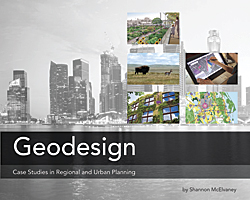Geodesign Books from Esri Available This Summer
A Framework for Geodesign: Changing Geography by Design
By Carl Steinitz
 A Framework for Geodesign: Changing Geography by Design focuses on design in general and geodesign in particular. As an idea, geodesign has the potential to enable more effective and symbiotic collaboration among several design professions, geographically oriented sciences, information technologists, and people impacted by change ("the people of the place") when all these groups aim to influence major environmental and social change for the better. According to author Carl Steinitz, this collaboration is essential.
A Framework for Geodesign: Changing Geography by Design focuses on design in general and geodesign in particular. As an idea, geodesign has the potential to enable more effective and symbiotic collaboration among several design professions, geographically oriented sciences, information technologists, and people impacted by change ("the people of the place") when all these groups aim to influence major environmental and social change for the better. According to author Carl Steinitz, this collaboration is essential.
Steinitz's framework, described here in detail, can contribute to that goal. It is clear that for serious societal and environmental issues, designing for change cannot be a solitary activity. It inevitably is a team endeavor with many participants from the design professions and geographic sciences, linked by technology from several locations for rapid communication and feedback, and reliant on transparent communication with the people affected by change. These demands create opportunities for geodesign and the need for organizing that collaboration.
Part I of the book is about the necessary but sometimes difficult collaboration between designers and scientists and also focuses on key aspects of study areas, scale, and size, which influence how geodesign is organized and carried out. Part II presents Steinitz's framework and addresses six key questions and their related types of models, which must be integrated in geodesign. Part III features nine case studies that illustrate different ways of designing for change, while Part IV explores the future of geodesign in research, education, and practice.
A Framework for Geodesign is not a how-to text or technical manual. It is a highly personal and sometimes opinionated and polemical book that is based on the author's longtime experience. It looks mostly to the future, with a primary intention of helping the collaborating participants achieve, in the words of the author, "practical benefits from geodesign." ISBN: 978-1-58948-333-0, 224 pp., $79.95.
Geodesign: Case Studies in Regional and Urban Planning
By Shannon McElvaney
 Geodesign: Case Studies in Regional and Urban Planning is a foundational text that describes how designers, planners, landscape architects, engineers, natural resource managers, public health officials, and others, use geodesign to meet or exceed sustainability, regulatory compliance, cost reduction, and social equity goals.
Geodesign: Case Studies in Regional and Urban Planning is a foundational text that describes how designers, planners, landscape architects, engineers, natural resource managers, public health officials, and others, use geodesign to meet or exceed sustainability, regulatory compliance, cost reduction, and social equity goals.
Geodesign promotes designing with geography instead of designing around geography. Geodesign integrates science and social and aesthetic values into landscape planning with geospatial tools that enable rapid, iterative evaluation of design alternatives against their probable outcomes. These tools let planners explore issues, collaborate with stakeholders, and resolve conflicts more easily, enhancing their chances for achieving the best possible design solutions.
Whether creating a growth strategy to increase open space and maintain rural character or optimizing a master plan to meet sustainability goals, the case studies in this book exemplify key steps, processes, and technologies crucial to solving the complex, interdependent issues that have become common to our rapidly changing world. They are meant to be educational and illustrative of the burgeoning need for near real-time impact simulation that enables decision makers to test design assumptions before committing dollars to construction.
Globalization, urbanization, population growth, climate change, and increasing demand on resources will drive the demand for smarter, more innovative design solutions that take into account the cumulative impact on the whole. ISBN: 978-1-58948-316-3, 160 pp., $19.95.
For more information about these books, visit esri.com/esripress.